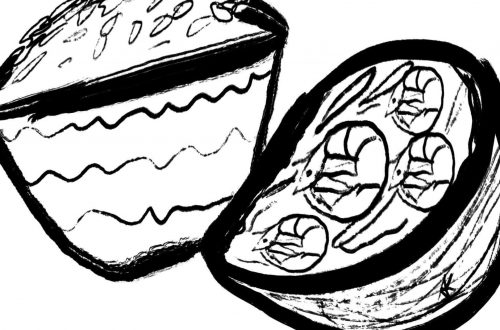By Abigail Shaffer
Abigail’s essay, “Field Peas for All Eternity,” appears in The Dirty Spoon Radio Hour, episode 2, which aired June 15, 2018.
I haven’t lived in Little Rock, Arkansas, for nearly seven years. Yep, nearly a decade. So you might be asking: why go there now?
I’m a gal of principles, you see. And while I don’t necessarily espouse a rigid set of life codes, per se, I do have three general guidelines for living, eating, and drinking:
- I don’t drink Guinness outside of Ireland. This is perhaps hardest of all, but it’s true. Guinness is total crap unless you’re on the Emerald Isle.
- I don’t gamble to Phil. Collins, that is. When I was a Vegas local, any time his music infiltrated my neighborhood bar as I lackadaisically dropped a $20 in the keno machine for drinks gratis, full stop on all button-pressing until Phil was no longer coming in the air that night.
- I don’t eat crawfish po’ boys anywhere but Maddie’s Place in Little Rock. (Sorry, Louisiana.)
Enter the owner of Maddie’s Place, Chef Brian Deloney, crafter of the aforementioned “there’s no place like home” magnificent crawfish po’boy. One of Little Rock’s own, he earned his formidable chops at the CIA in New York before landing a decade’s worth of serious gigs as Executive Sous Chef for Emeril Lagasse, at NOLA and then Delmonico’s at the Venetian in Las Vegas. (I need to research the Venetian’s Phil Collins policy.) The fare at Maddie’s Place definitely reflects Deloney’s formal culinary training and New Orleans influence, but Deloney owns it in a way that’s purely Arkansas and purely unique. Case in point, when asked what he’d serve two of my favorite folks, Queen Elizabeth II and Jack White, he mic-dropped: “Fried green tomatoes with crabmeat remoulade and crystal gastrique to start. For the Queen, shrimp and smoked cheddar grits with andouille reduction and for Jack, the buttermilk fried chicken breast with mac and cheese and slow cooked greens. They can both finish it off with bread pudding and rum sauce.”
And then there’s South on Main’s Chef-Bard Matt Bell, who, in a single badass conversation, managed to unite the soul-deep spokes of food, regionality, and history with his passion for local and regional food ways – in the form of a revelation that an entire freezer at SoM is dedicated to Crowder peas, about which he proclaims with infectious joy: Field Peas — Field Peas for all eternity! SoM’s regional mindfulness and passion for this connection is evident in offerings like pimento cheese agnolotti with country fried ham or catfish maque choux with fried okra and pepper jelly — most of the ingredients procured within the state, with virtually everything prepared in house, from the seasonal jams to the pickles.
Throughout my amazing conversation with my two old friends, what struck me most about Little Rock’s food culture is that a strong sense of adaptation and simply being Arkansan are truly the umami drivers of the entire food scene. So let’s take our field peas and our po’boys and tuck in for what’s happening in Arkansas.
Both Deloney and Bell emphasize that for anything to fly, for anything to be truly embraced, it must have a distinctly regional connection. Bell describes the process as starting first with local ingredients, be they Arkansas Basmati rice, ducks, tomatoes, okra, figs, or onions: “We speak to Arkansas through our ingredients. We take a universally-identifiable dish like a rice-meat-broth dish and give it a voice. It works when people identify with the nostalgia and with the Arkansas story. And that story comes to the people through our local ingredients.” Take roasted duck breast with sunchokes, sugar snap peas and charred green onions – all of which can be procured within an hour of the restaurant — or the country fried cauliflower with red potatoes, spinach, and onion gravy. Universal ingredients with entirely unique and regional voice.
We speak to Arkansas through our ingredients. We take a universally-identifiable dish like a rice-meat-broth dish and give it a voice.
Deloney concurs. “Arkansas food is genuinely Southern. I like taking old recipes and adapting them to new ways of cooking. A lot of times it’s simply to employ a little healthier method.” Deloney’s seared catfish with slow-cooked greens, black eyed peas and Creole tomato glaze illustrate the marriage of old school and clean modern through culinary technique. Deloney also points to the close connection between chefs and farmers. “We’ve got some of the best farming in the region. Many farmers cater to us chefs, which is really really cool, and they will essentially grow what we ask them to. The choices are endless.”
You can’t talk Arkansas food without talking about the people eating it. To get to the core and essence of Arkansas cooking, you have to wrestle out the intrinsic nature of what it means to be Arkansan. Back in the day, en route to the Alamo, Davy Crockett opined: “If I could rest anywhere, it would be in Arkansas, where men are of the real half-horse, half-alligator breed.” And while my North Little Rock native bro-in-law may be the stuff of similar legends, and the longest inland bayous in the country are just a bit to the south of Little Rock, the idea of the people intrinsically connected to land and place captures something inherent to the core nature of the contemporary food culture. Both Deloney and Bell cycle back to the human connection, the telling of story and the shared history of the people, as a defining element. “Everyone knows everyone, and I see it on a daily basis,” Deloney observes. “The lunch crowd mingling, networking, as they’ve always done.”
To get to the core and essence of Arkansas cooking, you have to wrestle out the intrinsic nature of what it means to be Arkansan.
What’s more, this interconnectedness plays out within the culinary community. Both chefs identify the importance of working relationships and friendships between Arkansas chefs. The formally-trained Bell says he got his real culinary education working with Arkansas native Chef Cassidee Dabney at the Capital Hotel (she’s since moved to Blackberry Farms in Tennessee). Similarly, Deloney emphasizes the importance of chefs working together: “We’re all friends. Whether it’s charity events or just hanging out, it’s so great to cook with guys and girls who I consider friends: chefs dedicated to making eating out better.”
Creating new visions and directions in Arkansas cooking is important. Bell notes, “We sit in a geographically interesting position, fringing the Midwest and Texas, for example, so we have these influences not seen so much in other regions of the South.” In fact, one characteristic of the Arkansas food scene is its adaptation and integration of myriad influences and styles. In addition to the many complex faces of Southern cooking inherent to the Arkansas culinary scene, including High Country, Appalachia-style mountain cooking, and a long and deep Delta/Cajun tradition, authentic regional Mexican cooking, reflective of the changing demographics in Arkansas, has begun to influence Little Rock’s culinary experience. Deloney explains, “Most of the chefs around here are taking on different cultures and creating diverse menus.” Bell observes that James Beard Semifinalist Chef Matt McClure for five years’ running and Food & Wine’s Best New Chef of the Midwest for 2015 – who, incidentally, whirs up the best parsnip puree I have ever eaten – is up at The Hive in Northwest Arkansas elevating cold weather mountain cooking whilst integrating influences of the rapidly-growing Pakistani and Indian populations around Fayetteville.
As Bell says, “Arkansas is an awesome cornucopia of styles and identities.”
Arkansas history is not the stereotypical antebellum hee-haw often glorified in many depictions of the South. Yes, there was big money and there IS big money (the third largest trading floor in the country is located in Little Rock), but poverty and hard-scrabble getting-by frame the Arkansas identity for many folks. Slavery and the subsequent indefensible history of civil rights atrocities and a violent, ugly and omnipresent white resistance to desegregation cannot be ignored, either. The contrast between the powerful and wealthy few and the rest of the folks is often stark.
But half-horse and half-alligator? Nowadays, unless there’s something I don’t know about my sister (born in Fayetteville) or my Dogtown-native BIL, that sort of description isn’t as relevant in contemporary application. The idea here is that Little Rock specifically, and Arkansas more broadly, is a conglomeration of cultures – dark horses and half breeds included – that cannot be struck from the narrative but is instead a defining and complexly-evolving characteristic.
The idea here is that Little Rock specifically, and Arkansas more broadly, is a conglomeration of cultures – dark horses and half breeds included – that cannot be struck from the narrative but is instead a defining and complexly-evolving characteristic.
Bell breaks it down:
“Here’s the thing. Arkansas has always taken in, sometimes amicably and sometimes not, an influx of all kinds of cultural and ethnic influences. The transition and adaptation has rarely been that smooth, but in the South, in Arkansas specifically, begrudging acceptance and fierce loyalty are inherent characteristics of Arkansas food culture and heritage in general. There’s a really interesting lineage tracing back to slavery, and it’s a conversation that must be had, even if it makes people uncomfortable. You take a dish like stewed tomatoes and okra and there’s an automatic heritage connection for many Arkansans – a deep-rooted cultural connection and draw. A longing for home and roots. It’s an Arkansas dish. Well, you take that same dish, maybe tweak the spices a bit, and a kid in West Africa is eating it all the time and thinking it’s West African. Having a conversation that acknowledges that connection – it’s the same and guess where it actually came from — and how so much of what we associate with Southern cooking is due to the slave trade, well, some people get uncomfortable. But we have to talk about it, because it’s a part of us. In the South, in Arkansas in particular, there’s a trait that even if something is forced on the culture, given enough time and appreciation, it becomes a part of the story. So this painful discussion becomes a part of the story, and you get to one of the coolest things about Arkansas food culture: food levels the playing field – you’re at a BBQ or tamale stand in the Delta, and no one’s thinking about race, they’re just thinking about the food.”
So antebellum anachronism definitely not, half-human clay eater perhaps a tad overly-reductive and generally offensive. Rather, the experience is more nuanced, the grey area a borderland country of acceptance and acknowledgment, a loathing of and yearning for a painful past, whilst stepping forward, with clear eyes, toward the future. It’s the bravery therein, the reckoning of a painful past, that often defines the character of the people, place, and food.
When I asked Deloney what he’d bring if he was stranded on a desert island (sigh), he replied “Doritos and Gatorade – don’t judge!” Sums it up: it’s the high and the low, it’s the crystal gastrique and the sack of Doritos Jacked, it’s the infusion of pain and loyalty, of making do and refined opulence. It’s working together, it’s owning up by force or time or just damn good food.
It’s the high and the low, it’s the crystal gastrique and the sack of Doritos Jacked, it’s the infusion of pain and loyalty, of making do and refined opulence.
Part of the food culture is the shared experience of connecting the people to place. When I think of Arkansas food, I also think of old-school Crescent Dragonwagon (James Beard winner and chef-author who ran a Eureka Springs B&B for years), I think of the amazing farmers and chefs and bartenders that I call my friends, I think of the passion and hospitality of the people I knew while I had the privilege of calling Arkansas my home. I think of the amazing climate (pots of cilantro on the patio all year round!), I think of three-story tall crape myrtles, rambling kudzu, the thick heat of Delta country, rainy season gully-washers so intense a primary character of my first novel was born from watching sheets of endless early summer rain.
Of course there’s a lot to get pissed off about: especially old Bubba and the narrow-minded prejudice and oppression that continue to influence current politics and worldviews. But there are also two-lane roads littered with crawfish shells tossed by slicked-up city cats attending the annual crawfish festivals in Dermott or Arkadelphia or Hot Springs, to sit on porches and nod hey at the stream of other city transplants escorting family members through crumbling streets to the heart of fading hometowns. There are Arkansas black apples, purple hull peas, catfish, the flashing trout and lean game of the Oachitas and Ozark ranges of the north. There’s also the Arkansas Basmati and fat ducks of the wide flatlands of the south and east, and the clear streams and mist over the water, as Crockett said, “such as nowhere else on the face of this universal earth.”
When asked what he would serve the Queen and Jack, Bell paused a mere beat. “I’d serve them both the same thing: our catfish, which is delicate and refined because it’s not fried, our three-bean salad with sorghum and sherry vinegar, and grit sticks using grits from Hanna Farms in Luxora. All local, delicate and refined for a queen, yet our take on trash cooking – which is totally rock’n’roll right?” Absolutely.






